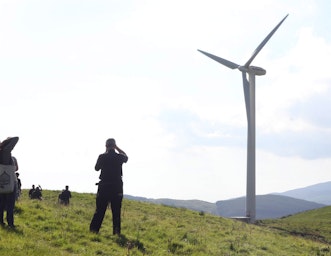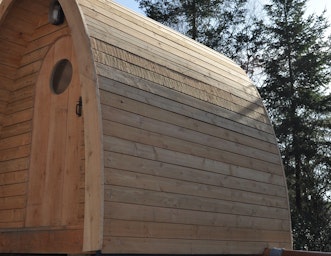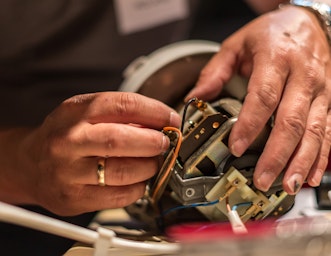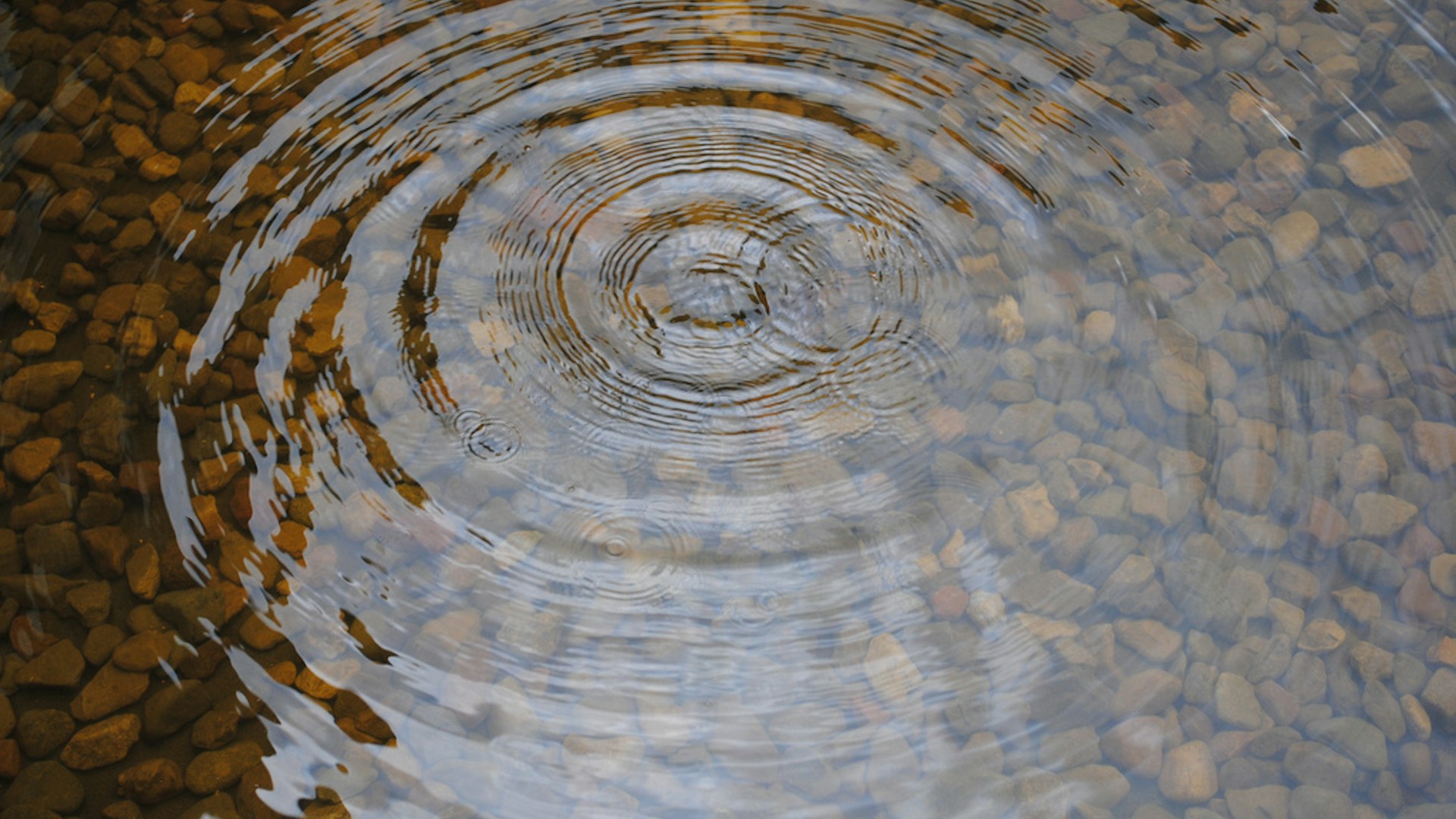
Reducing water use
The average domestic use of water in the UK is 150 litres per person per day, but it is easy to reduce this to 70-80 litres per day.
Behaviour changes, at little or no cost
- Taps run at between 5 and 20 litres per minute, so turn the tap off while brushing your teeth, avoid rinsing vegetables under a running tap, and so on.
- Turn the shower flow off when not needed – e.g. when using shampoo/soap.
- Wash your hands under a cold tap rather than running the hot tap until it is warm.
- Use a washing bowl rather than filling a large sink, and use as little hot water as is needed each time.
- Whenever possible, wait for a full load in the washing machine or dishwasher, rather than using half-load cycles (these can use three-quarters as much energy and water as a full wash).
- Gradually make changes in your garden to reduce how much watering it needs.
- In some households, not flushing the toilet every time after urinating may be OK.
Water saving gadgets and technical fixes
- Make sure all your hot pipe runs are insulated.
- Fix leaking taps by replacing washers, because a slight drip can waste 30 litres per day. Tap & ball valve washers are cheap and easy to fix.
- Many water companies supply free aerators you can fit to existing taps to reduce flow and save water. Check with your water company or see Save Money Save Water for this and other offers.
- For older toilets that use about 9 litres (2 gallons) or more, add a ‘cistern displacement device’ to reduce flush volume. This could be an expanding bag (often available free from your water company) or a plastic bottle filled with water. Avoid using a brick because these can crumble and cause problems. Check the device/bottle does not obstruct the mechanism, and the toilet still flushes OK with the reduced volume.
- Some toilets could have a new siphon unit or flush lever added to give low flush options.
- Check the flow rate of your shower with a container and stopwatch, and consider reducing the flow rate if appropriate. Although many showers will use less water than a bath, some can use quite a bit more. Power showers or old mixer showers can have a high flow of about 20 litres per minute. A flow restrictor or modern shower head can reduce this to 5 or 6 litres per minute and still perform well. Flow restrictors are sometimes free from your water company.
A few higher cost options
- Install a new low flush toilet.
- When looking at the plumbing in more depth, minimise ‘dead legs’ in pipes.
- Consider alternative toilets, such as composting loo or a waterless urinal.
Further information
To help you find water efficient products there is an EU energy label for water efficiency. You can read more about this at http://www.europeanwaterlabel.eu. That website includes a ‘find a product’ section, through which you can search for those that have the best rating.
Or you could ask your local suppliers which products they supply with an ‘A’ rating on that water efficiency label.
Related Questions
Can I collect rainwater for drinking?In the UK, treating rainwater to a high standard for bathing or drinking is not recommended. Besides the expense, the impact of all the equipment needed outweighs the environmental benefits of reducing mains water use. Small-scale water treatment systems use lots of energy in manufacture and use, and the filters need to be regularly replaced, creating waste.
Even systems for using rainwater for non-potable uses within a house have quite a high environmental impact.
If you are not on mains water then collecting and treating rainwater is an option – but in the UK, groundwater or a stream will usually be more reliable and need less treatment.
Treating rainwater to a higher level is more suitable in dry countries (e.g. Australia), or places with very dirty groundwater (e.g. Germany). In these cases, the extra expense and energy use might be justifiable against the alternatives.
A renewable energy technology could be ideal for pumping water where there is no mains electricity available, as a grid connection may be expensive and a diesel generator noisy and polluting.
Sizing a pump
The two main factors to consider when seeking a suitable pump are the flow rate – the amount of water that the pump will deliver, and the head – the height through which it will raise the water. These are related, as increasing the head will decrease the delivered flow. It’s important to minimise bends and other friction losses in pipework, as navigating these will require greater pressure, and as pressure and head are directly related, this effectively means a greater head.
Manufacturers’ technical data sheets will give the performance range of each pump, with graphs showing optimum combinations of flow and head. A pump sized properly to your needs will operate most efficiently. Suction pumps are limited to a depth of a few metres, so to draw water from a well or borehole, you’ll almost certainly need to lower in a submersible pump. Pumping wastewater or sewage necessitates one designed to handle drainage or effluent.
Small electric pumps for circulating water could cost tens of pounds, whilst those for drawing water from a well or borehole supply are likely to be a few hundred pounds. The main cost will be providing power to the pump, particularly when off-grid. Therefore, do first take all appropriate water-saving measures (such as spray-head fittings, mulches on plants to minimise water loss, etc) as these easily pay for themselves in the energy saved by reduced demand.
Off-grid electric pumps
Meeting a year-round water demand with a renewably-powered pump may require a combination of PV panels and a wind turbine, as this will balance energy production over the year. Sunshine and wind are naturally intermittent, so you may need some form of storage. Pumping water up to a tank (with demand then fed by gravity) during sunny or windy periods is more efficient than transferring the energy to batteries. If storing lots of water, you’ll need to balance the costs of a large tank (and supporting structure) against the costs of batteries (and their environmental impact and toxicity). An inexpensive control system can pump when needed, and otherwise divert power to batteries, giving extra backup facility.
The price of a small-scale renewable energy system will depend on the power and the maximum capacity needed. A very rough estimate is around £5 to £10 per installed watt. Siting generating equipment close to the pump minimises the cost and power loss incurred by cabling. As small turbines and PV panels usually produce power at 12 or 24 volts, a low-voltage pump would enable you to do without a costly inverter (for stepping up to 240 volts).
Mechanical pumps
For larger-scale pumping applications, you can avoid the losses in electrical systems by using mechanical power directly. See for example the question on our wind power page about wind pumps, or the question on our hydro power page about hydraulic ram pumps.
Modern shower heads may have a flow rate of 8 to 10 litres per minute. There are ways to reduce this to about 5 or 6 litres per minute and still have a vigorous and comfortable shower from a mains pressure supply.
Low-flow shower heads are now widely available. Some of the these ‘atomise’ the flow (delivering it in smaller droplets), some aerate the spray (giving the sensation of greater volume) and some reduce the number of jets.
A cheaper option that still works well is to fit a standard shower with an ‘Aquaflow’ regulator, giving a flow down to about 5 litres per minute. Some water companies have free flow regulators available, as part of their obligation to promote water-saving.
Try a 6 litre per minute regulator for substantial water savings, and if you find this not to give enough flow for your taste then you could upgrade to 7 litres or more, as desired.
Related events


Transformational International Energy Management
30th June 2025
Beekeeping Intensive
6th September 2025
Sustainable Woodland Management
10th November 2025Study at CAT: Our Postgraduate Courses
Related news

Bobbing along – the songbird that swims
10th March 2021
The joys of compost toilets
10th October 2019
Eye in the Sky
31st May 2019
Make do and mend
25th May 2019

Did you know we are a Charity?
If you have found our Free Information Service useful, why not read more about ways you can support CAT, or make a donation.
Email Sign Up
Keep up to date with all the latest activities, events and online resources by signing up to our emails and following us on social media. And if you'd like to get involved and support our work, we'd love to welcome you as a CAT member.
